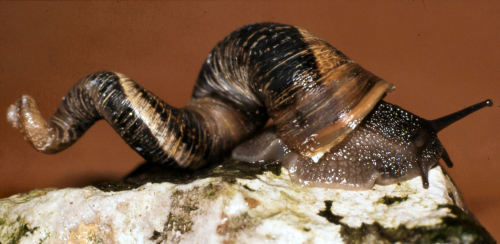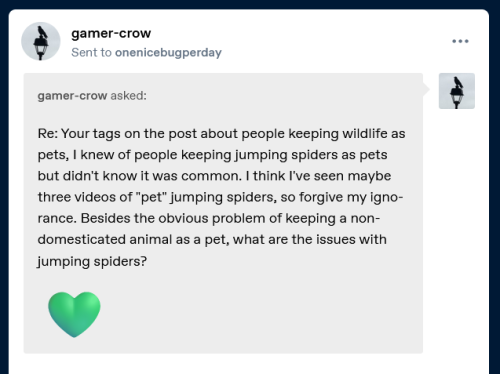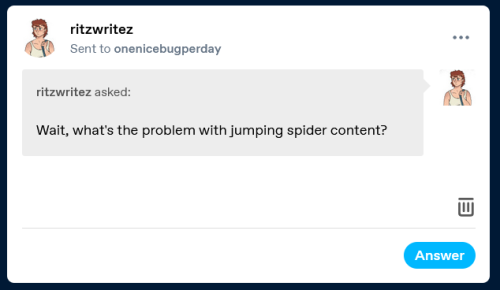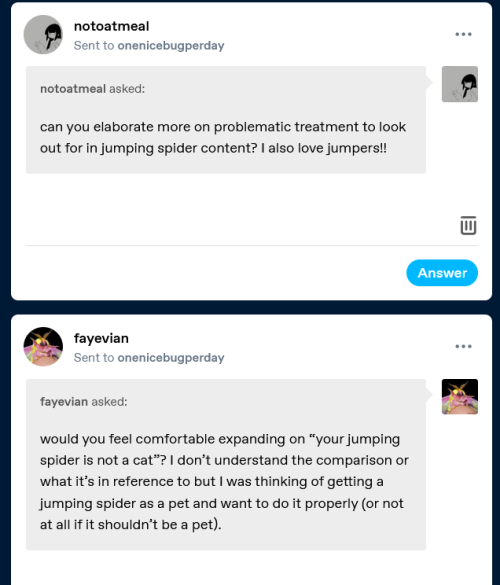I Heard A Commotion Of Buzzing In The Long Grass, So I Went In There In My Pajamas Because I Thought
I heard a commotion of buzzing in the long grass, so I went in there in my pajamas because I thought it might be a wasp attacking something (cool), but it was just a bottlefly getting upset because there was a sticky seed on his wing
More Posts from Phoronopsis and Others





Garden snails (Cornu aspersum) with scalariform shells, a rare genetic mutation.
Typical shell formation:

Photo 1 via The Malacological Society of London, 2-4 by saber_animal, 5 by joknight_nz, and 6 (typical shell) by benanna
TWO INJURED SEA COMBS CAN FUSE INTO A SINGLE ENTITY, AND THRIVE
In a surprising new discovery, scientists have found that two injured individuals of Mnemiopsis leidyi, a species of comb jellies or ctenophores, can fuse into a single entity. This phenomenon, which challenges our typical understanding of biological processes, reveals just how remarkable these planktonic creatures truly are.
Ctenophores, known for their translucent beauty and delicate movement in the ocean, appear to lack a mechanism called allorecognition—the ability to distinguish between self and non-self. This means that, when two comb jellies are injured and placed close together, they can merge, not just physically, but also functionally. Their nervous systems combine, allowing them to share nerve signals (or action potentials), and even their digestive systems become one.
The discovery was made by Dr. Jokura and his team, who were observing comb jellies in a seawater tank. After removing parts of their lobes and placing them side by side, they were astonished to see 9 out of 10 injured comb jellies fuse to form a single organism. Even more fascinating, the newly formed organism survived for at least three weeks, with its muscle contractions fully synchronized within just two hours. The digestive system also fused, enabling food taken in by one mouth to travel through their shared canal and exit through both anuses—although not at the same time!
While the exact benefits of this fusion are still unclear, the researchers believe that studying this phenomenon could provide valuable insights into how organisms integrate nervous systems and even how tissue regeneration occurs. It may also offer clues about immune system functions in species where the lines between individual organisms become blurred.
This discovery offers a glimpse into the hidden potential of the ocean’s lesser-known inhabitants, challenging what we think we know about biological boundaries and cooperation.
Video: Kei Jokura
Reference: Jakura et al., 2024. Rapid physiological integration of fused ctenophores. Current Biology
Even if a species of bug exhibits some kind of social touch among themselves (which I believe some are known to, though for the large majority of species I doubt there's any data on it), it's not going to be welcome from a towering colossus that they literally may not even be able to fit inside their whole field of vision. I feel like a lot of people forget just how big we are compared to most bugs
you know that one popular tumblr post that goes like "humans will pet anything" "well how wonderful that we live on a planet full of things that like to be petted!", or various other posts you see around the internet saying stuff like "humans evolved hands so we could pet all the animals 😌". sometimes I wonder how much those posts might have left actual lasting damage on public perception of animal behavior, like I'm sure they didn't intend to but like... did they
Well I certainly didn’t expect to illicit so many questions when I reblogged this post and added some tags about jumping spider content online.








Firstly, let me say there’s nothing wrong with keeping jumping spiders as pets. I have one myself. She’s a captive bred regal jumping spider. She’s currently a bit over two years old. I’ve had other jumping spiders as well, but they passed of old age and in one instance, a failed molt, which is fairly common.
Before and after getting pet jumpers, I joined some jumper groups, read a lot of care guides, and watched a slew of videos about keeping them.
It became obvious pretty quickly that apparently due to their cute fuzzy appearance, large round eyes, and intelligent behavior, people (owners, admirers, and popular content creators) assign human and mammal emotions and behaviors to them, often to their detriment.
I personally believe bugs are complex creatures that can be intelligent and have emotions, but that those emotions and behaviors are NOT analogous to human or mammal behavior and ignoring their natural needs and behaviors means you’re likely not providing proper care for them.
This is mainly about handling. Bugs don’t want to be handled. They get nothing positive out of it emotionally. They don’t want to be pet or cuddle with you. They don’t want to hang out with you. You’re a big scary predator, and it likely wants to get away from you. Forcing handling can stress, injure, or kill them. That’s why I tagged the post (linked above) “your spider is not a cat.” It doesn’t seek affection from you.
I can’t tell you how many posts or videos I saw where people were super upset because they let their jumper out of its enclosure to handle it and it either escaped and got lost or they somehow crushed it and killed or injured it badly. I’ve also seen people chasing their jumper around its enclosure trying to grab it or get it to jump onto their hand when it’s clearly just trying to hide.
As an example, a very common thing I’ve seen in videos about jumpers is people saying when they lift their front legs at you and jump or climb onto you/your hands it’s because they “want uppies” and want to be pet and be close to you. This is a wild misreading of behavior. Sometimes raising the front legs is a defensive display, trying to make itself look larger to scare away a threat. Other times, they’re waving their legs around to sense and feel their environment, or preparing to jump onto something. They are arboreal, and their natural behavior is to find a high vantage point, so climbing onto the big thing (you) nearby is normal. It’s not because it seeks your affection.
Certainly if you DO handle them frequently they can get used to it, and it becomes less stressful for them. But in my opinion the dangers outweigh any positives, and I don’t handle mine. These are wild animals that have not been domesticated, even when captive bred. If you want to give them enrichment, and you should, offer them prey to chase or interesting things to explore in a larger enclosure. For those that do still handle them, I’d encourage you to watch their behavior closely and read the spidery cues they’re giving you rather than assuming they’re feeling what a cute little mammal might be feeling in the same scenario.
I could go on with specifics about certain videos, but I wasn’t planning on writing a huge post and this is already long. Also I’m sure many people would disagree with me about some things I’ve said, and I’m not going to argue about anything. This is just how I feel based on what I’ve seen of online jumping spider content, and it’s why I no longer interact with most of it.
Did you know blowfly larvae living in carcasses leave behind chemical cues which they actively seek out in order to aggregate in large groups, even with other species 😃 (source 1, 2)
^ my decomposing corpse lying out in the middle of the wilderness talking to the crows
I like making bets about things that happen in the far future and being like “if I’m wrong you can bring me back from the dead and say I told you so”, except haha sucker I’ll be long-eaten by flies by then, and those flies will have been eaten by toads and those toads will have been eaten by more flies; can’t bring me back when my atoms are already recycled and scattered all across the web of life, feeding and being fed upon, fluttering through countless existences before inevitably moving on; how many lives I have lived, how many lands my substance has visited, I am in the air and the water and the rock, how can you bring me back when I am already here
if you do bring manage to bring me back though you’ll have to also bring back a bunch of flies and toads and stuff so have fun with those
me walking up to the whalefall: hey my fellow hagfish hows it slimin' hagatha (she's a hagfish): are you sure you're a hagfish? you look kinda like some kinda lungfish me: haha dont worry check this out (i breathe in some pollen) HURHUHUHHHUUUURURGURGUGRGG hagatha: yep, that's a hagfish-y amount of slime. come hag out! (hagfish for hang out)
Invertebrates are definitely capable of learning! A lot of people who don’t know anything about bugs say they’re automata who just do everything by instinct like an if-then computer program, and they absolutely have not looked into it because there’s SO much literature on invertebrate cognition including learning. One of the neatest papers I’ve seen was about Drosophila fruit flies (there’s a ton of fruit fly literature cuz they’re a common lab animal). So when a female fruit fly is exposed to parasitoid wasps, she will start laying fewer eggs. These researchers showed that fruit flies who have been exposed to wasps can communicate the presence of a threat via wing movements to other female fruit flies, and those flies will start laying fewer eggs too even if they haven’t seen the wasps at all, an example of social learning.
But what’s more: they can communicate threats like this not just with flies of their own species, but with flies of closely related species too. If the species are too distant, they stop being able to communicate as successfully HOWEVER these authors showed that if you house a bunch of flies together in mixed-species groups, afterwards their success at communicating goes up! This suggests the existence of a fruit fly “language” which differs between species, but which they’re capable of learning other species’ languages as well! Sources: 1, 2
see also this very scientific diagram from here:

One interesting thing about those studies is that they found that if you raise a fruit fly in isolation from hatching, it won’t be able to communicate as well. This suggests that there’s a critical period of socialization which flies require to learn how to do communicate properly and without it their ability to do so is impaired. (I believe there’s other studies on how other social interactions are affected by social isolation but I haven’t read them; again there’s sooo much fly literature ^^)
Another cool one I’ve seen is on antlion larvae, who hunt by digging pits and then waiting in the middle for ants and other bugs walking by to fall in. It’s generally thought that sedentary animals have fewer cognitive capabilities than mobile ones, due to their less demanding lifestyle, however these studies (which I’ve only skimmed) have been carried out which demonstrate that they are still capable of learning. Specifically, they can be taught to anticipate and identify approaching insects based on vibrations in the sand, and will subsequently adapt their behavior to hunt more efficiently! Even animals with what seems like a simple feeding behavior are still very capable of modifying it, which makes sense evolutionarily; while obviously different animals will require different levels of intelligence, you can imagine in a lot of cases that being able to modify your behavior based on experience is distinctly advantageous. Source 1, 2
Not an arthropod, but another bug that there’s been a lot of research into is Lymnaea pond snails, which are another common model organism for studying neurology and cognition. A ton of work has been done on their capabilities for associative learning, i.e. classical conditioning (“dog learns to salivate at the ring of a bell”) and operant conditioning (“rat learns that pressing a button gives food”). It’s been found that their ability to learn is actually a lot more complicated than just those simple kinds of stimulus ↔ response. They can take stuff they’ve learned in stressful situations (simulated experimentally by exposing them to the smell of crayfish, which eat snails) and generalize it to situations beyond just the original context, which you can imagine must be pretty important for surviving in the wild. Conversely, they can also place memories in context: when taught stuff in the presence of both crayfish smell and carrot smell, subsequently they will recall what they’ve learned in response to the carrot smell alone; in other words, they’re not just learning “carrot + crayfish smell”, but “carrot smell = crayfish smell”, placing their memories in the broader context of their environment (which again, must be helpful for survival). So they can not just learn but pretty flexibly as well! Sources 1, 2, 3
This isn't a bug at all but pretty recently there was a study that found that box jellyfish are capable of associative learning. This one research lab has done a lot of work into vision in the Caribbean box jellyfish (they have eyes btw) on both a behavior and a neurological level and have found a lot of cool things, like that these box jellyfish use their vision to navigate through their habitat of mangrove forests, and that though they don't have a brain as such, they do have a central nervous system in the form of a ring nerve connecting four small clusters of neurons that process and combine input from their eyes. I can't actually read the paper (paywall :P) but last year they did an experiment where they put jellies in a tank with darkened bars on the glass to simulate mangrove roots. Normally the jellies gauge the distance to a root by how dark it appears and then swim around it when they get near; however the bars in the experiment were colored so that they looked like they were farther away than the wall actually was. At first the jellyfish kept bumping into the all, but after several rounds of trial and error they began to avoid them, indicating that they were able to learn from the experience! Jellyfish! Aaaaa nature is so cool. Source 1, 2, 3
I have a question! About bugs and arachnids and all them. Sorry to lump them all into one category, but I'd rather not make the same post multiple times.
My question is: Can they learn "tricks?"
By this I mean are they capable of learning, in general, I suppose. Like mice in a maze, magpies with a rock.
Also, what sorts of things have they learned? How do they learn (like watching others or from experience)?
I ask because it's something that really interests me. I know the ability to learn doesn't add or subtract value from a being, it's a curious thought as I know very, very little about beetles, and spiders, and bees, and so on!
Do they just know how to do things because it's all their kind have done since the beginning of them? Do they have to learn or are capable of it?
I saw this one paper where they made an artificial neural network based on the actual neural architecture of the fruit fly and trained it on pictures of flies to show that 1. individual fruit flies are visually distinct 2. they are probably able to differentiate between each other visually despite their vision being terrible. And as a comparison they had a bunch of experienced fly scientists (aka “flyentists”) try to identify the same pictures of flies and they failed miserably which I thought was really funny
This ability to re-identify flies across days opens experimental possibilities, especially considering that this performance was achieved with static images (16fps yields around a thousand estimates of ID per minute, allowing high confidence in the parsimonious correct identification). This is in contrast to the human ability to re-identify flies, which at low resolutions is barely better than chance.
Clearly, all models can learn to re-identify flies to some extent, underscoring the individual-level variation in D. melanogaster. Re-identifying flies is in fact easier for DCNs than CIFAR10 (at least with centred images of flies acquired at the same distance). Even the model that rivals, in some sense, the representational performance of humans does ten times better than humans. Why humans can’t tell one fly from another is not clear. Regardless of whether it was evolutionarily beneficial to discriminate individual flies, humans do have incredible pattern detection abilities. It may simply be a lack of experience (although we attempted to address this by only using experienced Drosophila researchers as volunteers) or a more cryptic pattern-recognition ‘blind-spot’ of humans. In either case, these findings should spur new experiments to further understand the mechanisms of human vision and experience and how they fail in this case.
these CRINGE scientists FAILED to identify flies that all our models could smho 🙄😤
scientists: oh hey we found a new species of deep sea feather star, neat :)
the news: TERRIFYING and ALIEN creature with ONE THOUSAND ARMS discovered LURKING in the DEEP ABYSS of the sea
the public: omg im never swimming in the ocean again!!!
the animal:

-
 ionfusionpunk reblogged this · 2 weeks ago
ionfusionpunk reblogged this · 2 weeks ago -
 ionfusionpunk liked this · 2 weeks ago
ionfusionpunk liked this · 2 weeks ago -
 26velociraptors liked this · 2 weeks ago
26velociraptors liked this · 2 weeks ago -
 the-starry-seas reblogged this · 2 weeks ago
the-starry-seas reblogged this · 2 weeks ago -
 baileyblues reblogged this · 2 weeks ago
baileyblues reblogged this · 2 weeks ago -
 disapprovinghmm reblogged this · 3 weeks ago
disapprovinghmm reblogged this · 3 weeks ago -
 floralgrizzly reblogged this · 3 weeks ago
floralgrizzly reblogged this · 3 weeks ago -
 idislikethissite reblogged this · 3 weeks ago
idislikethissite reblogged this · 3 weeks ago -
 reineyday liked this · 3 weeks ago
reineyday liked this · 3 weeks ago -
 thebansacredbanned reblogged this · 3 weeks ago
thebansacredbanned reblogged this · 3 weeks ago -
 thebansacredbanned liked this · 3 weeks ago
thebansacredbanned liked this · 3 weeks ago -
 oregano-shipment liked this · 3 weeks ago
oregano-shipment liked this · 3 weeks ago -
 littleleafsandlizards reblogged this · 3 weeks ago
littleleafsandlizards reblogged this · 3 weeks ago -
 spongeyrocksrock reblogged this · 3 weeks ago
spongeyrocksrock reblogged this · 3 weeks ago -
 the-dishes-need-doing reblogged this · 3 weeks ago
the-dishes-need-doing reblogged this · 3 weeks ago -
 those-fucking-feratu reblogged this · 3 weeks ago
those-fucking-feratu reblogged this · 3 weeks ago -
 acidmatze reblogged this · 3 weeks ago
acidmatze reblogged this · 3 weeks ago -
 pinkpowerwizard reblogged this · 3 weeks ago
pinkpowerwizard reblogged this · 3 weeks ago -
 pinkpowerwizard liked this · 3 weeks ago
pinkpowerwizard liked this · 3 weeks ago -
 taray97 reblogged this · 3 weeks ago
taray97 reblogged this · 3 weeks ago -
 taray97 liked this · 3 weeks ago
taray97 liked this · 3 weeks ago -
 clueless-dullahan reblogged this · 3 weeks ago
clueless-dullahan reblogged this · 3 weeks ago -
 clueless-dullahan liked this · 3 weeks ago
clueless-dullahan liked this · 3 weeks ago -
 jamboreeguy reblogged this · 3 weeks ago
jamboreeguy reblogged this · 3 weeks ago -
 highroadpenis reblogged this · 3 weeks ago
highroadpenis reblogged this · 3 weeks ago -
 highroadpenis liked this · 3 weeks ago
highroadpenis liked this · 3 weeks ago -
 owl-fruit liked this · 3 weeks ago
owl-fruit liked this · 3 weeks ago -
 its-calleda-lance reblogged this · 3 weeks ago
its-calleda-lance reblogged this · 3 weeks ago -
 its-calleda-lance liked this · 3 weeks ago
its-calleda-lance liked this · 3 weeks ago -
 johannestevans liked this · 3 weeks ago
johannestevans liked this · 3 weeks ago -
 dumbkiwi reblogged this · 3 weeks ago
dumbkiwi reblogged this · 3 weeks ago -
 dumbkiwi liked this · 3 weeks ago
dumbkiwi liked this · 3 weeks ago -
 glitterandgrunge reblogged this · 3 weeks ago
glitterandgrunge reblogged this · 3 weeks ago -
 glitterandgrunge liked this · 3 weeks ago
glitterandgrunge liked this · 3 weeks ago -
 bodypositivityandglitter reblogged this · 3 weeks ago
bodypositivityandglitter reblogged this · 3 weeks ago -
 ethan-elliott liked this · 4 weeks ago
ethan-elliott liked this · 4 weeks ago -
 igorina-igorowicz reblogged this · 1 month ago
igorina-igorowicz reblogged this · 1 month ago -
 tryin-my-best-here reblogged this · 1 month ago
tryin-my-best-here reblogged this · 1 month ago -
 blendedwhiskey liked this · 1 month ago
blendedwhiskey liked this · 1 month ago -
 kittyphones liked this · 1 month ago
kittyphones liked this · 1 month ago -
 gaysagainstjaywalking liked this · 1 month ago
gaysagainstjaywalking liked this · 1 month ago -
 fireproofandfestive liked this · 1 month ago
fireproofandfestive liked this · 1 month ago -
 missgwendolenfairfax reblogged this · 1 month ago
missgwendolenfairfax reblogged this · 1 month ago -
 frisktastic reblogged this · 1 month ago
frisktastic reblogged this · 1 month ago -
 e-arteast liked this · 1 month ago
e-arteast liked this · 1 month ago -
 101-android-luvr-010 liked this · 1 month ago
101-android-luvr-010 liked this · 1 month ago -
 manorinthewoods liked this · 1 month ago
manorinthewoods liked this · 1 month ago -
 hrooo-hroo-hroo reblogged this · 1 month ago
hrooo-hroo-hroo reblogged this · 1 month ago -
 the-fangorn-forest liked this · 1 month ago
the-fangorn-forest liked this · 1 month ago -
 blizmo liked this · 1 month ago
blizmo liked this · 1 month ago


